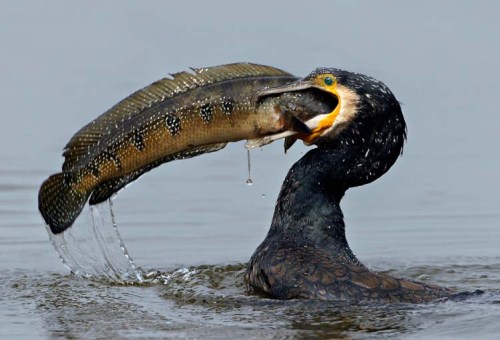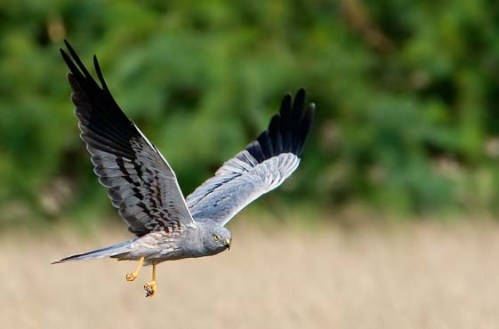In a previous article I wrote about the tragic collision of two Avro Lancaster bombers, both of them from 103 Squadron at Elsham Wolds. The two aircraft were both trying to land at the same time, after permission to do so had been given to each of them by the Flying Control Officer. A subsequent Court of Inquiry found that “the accident was caused by the Flying Control Officer departing from the normal procedure.” They recommended that “Flying Control Officers must not depart from the normal procedure for landings”.
In the accident, therefore, Lancaster ND334, PM-unknown, was struck in mid-air by a second Lancaster Mk III, JB530, PM-F. That careless act, caused by the unfortunate decision of a still unnamed Flying Control Officer resulted in the deaths of five young men, namely the Flight Engineer Sergeant D.H.J.Cunningham, the Navigator Flying Officer R.H.Fuller, the Bomb Aimer Flight Sergeant C.Bagshaw, the Wireless Operator Sergeant E.S.Gunn and the Rear Gunner Sergeant A.O.Haines:

Sadly, this collision was not the first accident of this type to have occurred at Elsham Wolds. Searching on the Internet, I found a website detailing a collision which took place on December 16th 1943, as both aircraft took off to bomb Berlin. The accident involved one aircraft of 103 Squadron and one from 576 Squadron who were also based at the same airfield.
Apparently, low cloud was present and this was thought to provide a potential source of danger for the aircraft as they took off. At the pre-raid briefing, therefore, all of the crews were clearly told to climb away “into the climbing pattern” as soon as they left off the ground, and then to continue climbing until they reached the correct height to set off with the bomber stream across the North Sea to the target. Great stress was put on the problems which were possible with the low cloud base and that everyone should stick, therefore, “to the instructions”.
The first of the two doomed bombers to take off, at 4.36 p.m., was Flight Sergeant F.R.Scott of the Royal Australian Air Force in Lancaster LM332, UL-B2 of 576 Squadron. It was the crew’s very first mission:
They were followed, at 4.37 p.m., by the second doomed aircraft, Lancaster JB670, PM-unknown, of 103 Squadron. The pilot was Flight Sergeant Richter and the crew were a last minute mixture of men from the two squadrons. This was fairly unusual, but I cannot see why it would have made any difference to events:
As JB670 climbed away from the runway, LM332 came out of the clouds and there was a head-on collision, more or less directly over the village of Ulceby. As you might expect, nobody survived and the lives of fourteen young men came to a very abrupt end. Certainly, it would have been so quick that many of the crew may well have known very little about it. Wreckage was littered everywhere:
Nowadays a plaque has been set up at the site of the War Memorial, remembering all fourteen men:
On board the Lancaster JB670, PM-unknown, of 103 Squadron, the pilot was Flight Sergeant Valentine “Val” Richter, aged 22, of Chingford, Essex. He was a member of 576 Squadron.
The Flight Engineer was Sergeant Frederick Stanley Copping, aged 21, of Walthamstow, Essex. The navigator was Flying Officer Charles Reginald Jaques, aged 30, of Winterton, Lincolnshire, also a member of 576 Squadron.
The Bomb Aimer was Flight Sergeant Thomas Leslie Hobson Kay of the RAAF, aged 22, and from Redhead, New South Wales, Australia.
The Wireless Operator was Sergeant Peter Coopman. He was aged 21, and came from Cropthorne, Worcestershire.
Sergeant Cyril Walter Plampton was one of the two gunners. He was a member of 576 Squadron.
The other gunner was Sergeant Francis Andrew Furrie. Young Sergeant Furrie was taken back to Scotland, to be interred in the New Stevenston (St Patrick’s) Roman Catholic Cemetery in Glasgow:
He was the only member of the crew not to be buried in Cambridge City Cemetery:
For the Avro Lancaster III, LM332, UL-B2 of 576 Squadron, the pilot was Flight Sergeant Frederick Roy Scott of the RAAF. He was 24 years of age and came from Cabramatta, New South Wales, Australia. Here are the shops in Cabramatta nowadays:

The navigator was Sergeant George Gordon Critchley. Apparently his father was a miner in St Helens in Lancashire. The family lived in a tiny terraced house but both sons, George and his brother Harold won scholarships to a Catholic Grammar School called De La Salle in the West Park area of the town. It was run by the Jesuits, and allowed Gordon to avoid the coal mine like his father, in favour of the much cushier Civil Service in London.
The Flight Engineer was Sergeant Stanley Victor Cull. He was aged only 18 and was possibly the youngest casualty in Bomber Command in 1943. He came from Windsor in Berkshire.
The Wireless Operator was Sergeant John Hamilton Caldwell . He was 21 years of age and came from Glasgow.
The Bombaimer was Flight Sergeant Peter Martin Crowle Ellis. He was the beloved son of the Reverend Crowle Ellis, B.A. and Mrs Crowle Ellis, of The Rectory, Northfield in Birmingham.
One of the gunners was Flight Sergeant Brian Price Wicks of the RAAF.
Brian was only 20 years of age and came from Highgate in South Australia. He was a clerk before he joined up.
The other gunner was Sergeant Joseph William Ross. He was also only 20 years of age and came from Westminster in London.
On the website which has supplied a good deal of the information I have used for this article, the collision is actually described by an eye witness, Marie Harris. Here is a very much abridged version of her words. I would strongly urge you to follow the link and read the full story for yourself. There are also a number of photographs of crewmembers on the site. They will give you a good idea of just how young these men were when they lost their lives so tragically:
I was a driver at Goxhill Haven in 1943. Most of the RAF were Air Crew and you would dance with one or two, and have a great night. Next evening you would ask “where’s Alec, Bob and Bill?” A shrug of the shoulders and you knew and felt very sad.
As I drove around you would see the Bombers going off and up into the clouds and away, up into one circle, two circles and third circle away on their mission.
Around 4.30 I was driving past a farm, it was very low cloud and the Lancasters were taking off into the circles, up and away. They were so low and so near.
One went into this low cloud and I was thinking it’s a wonder they don’t crash they are so close together, when in a split second as it came out of the cloud, God, it was a head on crash with another Lancaster, one almighty explosion and all Hell was let loose. It was awful, I couldn’t believe what had happened practically over my head, just over the farmer’s field. I was so stunned, streaks of fire shooting all over the road. In no time at all the fire engines were arriving. I still couldn’t believe what had happened. I pulled up at the Guard House. I was rooted to my seat and couldn’t stop crying, thinking of the Bobs, Alecs and Bills just blown to bits. It was awful and still is.
They took me into the Mess and gave me a cup of hot strong tea
When I went to bed I couldn’t shut my eyes, this terrific explosion flashed before me every time. I was like this for quite a few nights. I can’t bear even to this day to watch a film with planes crashing. I shut my eyes or go out of the cinema.Driver Marie Harris W/44133 ATS.
This raid on Berlin seems to have been a complete disaster. My own researches show that, unless I have made some grotesque error in my counting, around 58 Lancasters were destroyed and not far short of 300 young aircrew were killed.
A total of 483 Lancasters had set off for Berlin along with 15 Mosquitoes. Some 25 Lancasters were destroyed during the raid itself as they overflew the target, attacked by anti-aircraft fire and night fighters.
On the return journey to England, a minimum of 29 Lancasters were destroyed between Berlin and home:
Some of this was down to the persistent German night fighters, but the greatest problems seem to have come when the bombers all arrived back at their respective bases. That very same low cloud which had caused the collision at Elsham Wolds was still there. It had not dissipated at all since the bombers had taken off at the beginning of the night, with catastrophic results for many aircraft:
There is a slight difference in overall totals which I cannot readily explain, other than some aircraft may have crashed in England and then been repairable. Whatever the explanation, that is still a lot of young men to lose in just one cloud covered night.
One final word. All of the websites I have used can be reached through the links above. I could not have produced this article, however, without recourse to the superb books by W.R.Chorley. Their detail is almost unbelievable and I would urge anyone interested by the bomber war to think seriously of purchasing at least one of them. The books bring home just how many young men were killed in Bomber Command during the Second World War. When the first book of the series arrived, my daughter thought it contained all the casualties for the whole war, but, alas, it was just 1944.









































































































